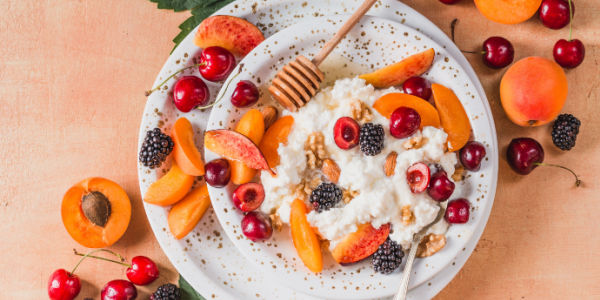
Considering the food you stock in the kitchen ends up on the dining table, what lands in your grocery cart can truly make or break your weight loss efforts. But by creating (and sticking to) a diet grocery list, you can maximize your results and even minimize your bill. Not sure how to get started? Look no further than this healthy food shopping list!
Your Healthy Food Shopping List
Breads, Grains, and Pastas
While trying to lose weight, individuals often fork out their beloved carbs. However, they can absolutely fit into a balanced diet with a few simple considerations: Look for the words "whole wheat" or "whole wheat flour" as the first ingredient on the label, choose whole-grain breads that contain at least 3 to 4 grams of fiber, and ultimately, whole grains should comprise at least 50 percent of total grain consumption.
• Brown rice
• Oats
• Quinoa
• Whole wheat bread and English muffins
• Whole grain pasta
• Whole grain tortillas
Produce
Though going for fresh products is encouraged, frozen products are also viable options. But when maneuvering through the frozen section, be weary of added sugar, sodium, and other preservatives. Nonetheless, offer variety in the produce you pick, including the listed fruits and veggies.
Fruits
• Apples
• Avocados
• Bananas
• Berries, all varieties
• Cantaloupes
• Grapes
• Grapefruits
• Oranges
• Peaches
• Pears
• Watermelons
Veggies
• Asparagus
• Bell peppers
• Broccoli
• Carrots
• Cauliflower
• Celery
• Cucumbers
• Kale
• Mushrooms
• Onions
• Spinach
• Sweet Potatoes
• Zucchini
Dairy and Eggs
When it comes to purchasing dairy products, going for low-fat and fat-free options is common in response to previous diet recommendations. However, new research suggests the switch may not be necessary, even showing consuming full-fat dairy products can reduce obesity and diabetes risks. Nonetheless, if you do go for whole products, it is still important to moderate portions and servings.
• Eggs
• Greek yogurt, plain
• Cottage cheese
• Milk, including dairy and plant-based varieties to accommodate personal preferences and dietary needs
• Shredded cheese
• String cheese
Meats and Seafood
Cheese lean cuts of meat and trim visible fat prior to cooking. Lean cuts of meat are full of protein and have little or no visible fat. And if you are to select deli meats, go straight to the butcher to reduce added salts and preservatives.
• Chicken breasts, boneless and skinless
• Grassfed ground beef, at least
• Salmon
• Shrimp
• Sirloin
• Turkey breasts
• Tilapia
Canned and Jarred Goods
With most packaged goods coming with added ingredients for preservation purposes, either 1) look for products without added sugars and oils or 2) rinse off before use (i.e. the salt on beans).
• Applesauce
• Beans, including black, kidney, and pinto
• Canned tuna and/or salmon
• Peanut Butter
• Pickles
• Pumpkin
• Tomato sauce
Snacks
Sometimes snack attacks come are insistent and unavoidable. But rather than responding with a big of chips, answer to its call with these more nutritious options.
• Dark chocolate squares, at least 70 percent or higher
• Jerky, including beef and turkey
• Nuts and seeds, including almonds and pumpkin seeds
• Popcorn, unsalted and unbuttered
• Individual pretzel bags
Condiments and Oils
Condiments and oils deliver flavor to numerous foods, though they can also add unwanted calories from refined oils, sugars, and other additives. Simultaneously boost flavor and nutrients with these choices, while still being mindful of the amount used and utilizing Nutrition Facts and Ingredients labels.
• Balsamic vinegar
• Coconut Oil
• Mustard
• Olive Oil
• Pure maple syrup
• Reduced-sodium soy sauce
• Salsa
• Sriracha
Additional Grocery Shopping Tips
Beyond formulating a healthy food shopping list, utilize these additional tips:
• Shop the Perimeter
When visualizing a grocery store, picture boundless rows of various cereals, breads, pastries, cookies, chips, and other packaged snacks are likely visualized. So skip the weaving in and out of the aisles and mostly stick to the store’s perimeter, as doing so lessens the temptation of highly processed products and encourages focusing on more nutritious and wholesome food items listed above.
• Time Your Shopping
Perhaps one of the worst times to grocery shop is not based on crowds or store sales... But when hunger strikes! Going shopping while hungry cannot only lead to longer trips to the store, but a fuller cart of items you did not necessarily intend to purchase. If grocery shopping leading up to mealtime, choose a nutritious option to snack on in between, including Greek yogurt, a piece of fruit, or a cheese stick.
• Use Self-Checkouts
Use a self-checkout if offered, as most common checkout and register lines are loaded with temptations for impulse buys even in the absence of hunger. Utilizing a self-checkout can reduce the urge to grab candy, chips, and other convenience snacks.







